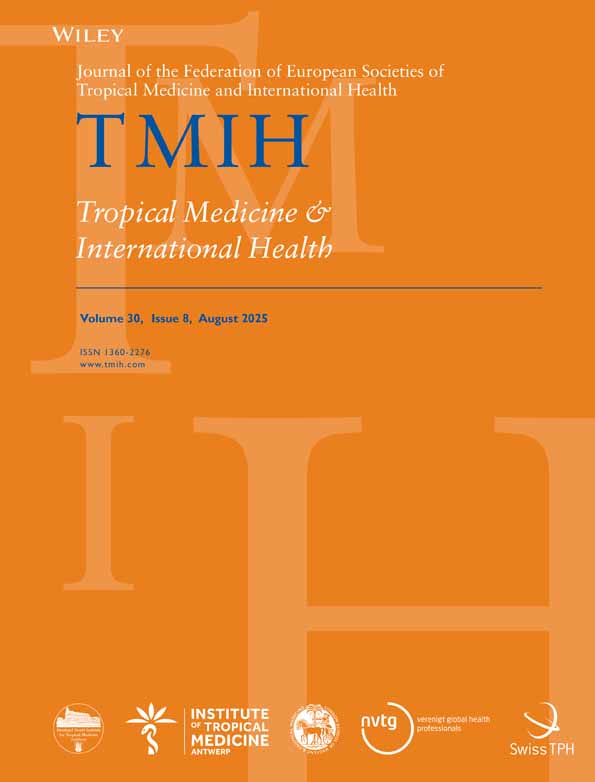Short communication: Susceptibility of Culex sitiens to Japanese encephalitis virus in peninsular Malaysia
Abstract
The susceptibility of Culex sitiens to Japanese Encephalitis (JE) virus was examined in the laboratory. Cx. sitiens became infected with JE virus on day 8 and subsequently it is able to transmit the virus when it takes a blood meal. Both parts of the experiment were carried out using artificial membrane feeding technique.
Introduction
Japanese encephalitis (JE) virus is common in much of Asia. The natural transmission cycle involves Culex tritaeniorhynchus and other Culex mosquitoes, such as Cx. gelidus and Cx. Vishnui, which breed primarily in rice fields and feed on humans in the early evenings (Shope 1990). In a study in Sabak Bernam, Selangor, Malaysia, where a case of JE had occurred, two pools of Cx. sitiens were found positive for JE virus. This was the first isolation of JE virus for this species of mosquito (Vythilingam et al. 1994). The virus isolation, however, does not provide conclusive evidence that Cx. sitiens is a potential vector. Mosquitoes containing blood were excluded from examination but it is possible that a mosquito in the pool had recently fed on an animal with viraemia.
Moreover, although the virus taken up was detected, it might be incapable of multiplication in the mosquito. Even if multiplication was possible, the mosquito might be incapable of transmitting the infection. Therefore, our aim was to determine if JE virus multiplies in Cx. sitiens after an infective feed and its capability in transmitting JE virus.
Methods and materials
Culex sitiens obtained from the field were colonized in the insectary of the Institute for Medical Research in Kuala Lumpur. Aedes togoi maintained in the insectary were used as controls in the study. The experiment was conducted in two parts: in the first experiment, 4–5-day-old Cx. sitiens were starved for 24 h and then provided with JE (Nakayama strain) infected blood meal by an artificial membrane feeding apparatus. This apparatus is a hollow glass cone with an extended tube surrounded by a cylindrical water jacket provided with an inlet and outlet for connecting rubber tubing to a circulating water bath maintained at a constant temperature of 37 °C. The bottom of the feeder is covered with baudruche membrane. The feeder was placed on top of the mosquito cup so that the membrane was accessible to the mosquitoes for feeding. Fed mosquitoes were then maintained in paper cups and provided with cotton pads saturated with a mixture of diluted sugar solution and vitamin B complex. These cups with mosquitoes were kept in cages in the infection room. Two mosquitoes were removed from day 0 until day 12 at every 2 days and kept at −70 °C.
The mosquitoes were homogenized and inoculated into C6/36 cell line. This was incubated for 7 days. RNA was then extracted from the culture fluid and reverse transcriptase-polymerase chain reaction (RT-PCR) was carried out to detect JE virus according to the procedure described by Vythilingam et al. (1995).
For the second part of the experiment, Cx. sitiens were provided JE-infected blood meal as described above. The mosquitoes were then maintained for 12 days. They were then starved for 24 h and afterwards provided a normal blood meal using the membrane feeding apparatus. The fed mosquitoes were maintained for 2 days to digest the blood. The remaining blood from the membrane feeding apparatus was transferred to an Eppendorf tube and centrifuged to obtain the serum. RT-PCR was carried out directly on the serum using the same procedure as for culture fluid (Morita et al. 1991). The head and thorax of the mosquitoes were homogenized and inoculated into the C6/36 cell line. The procedure for detection of JE virus followed the same protocol as in the first part of the experiment.
Results
The RT-PCR results showed that Cx. sitiens were positive on days 0, 8, 10 and 12. On days 2, 4 and 6 they were negative. The percentages of Cx. sitiens and Ae. togoi infected were 66.6 and 80%, respectively. The serum and head and thorax of the mosquito from the second part of the experiment were also positive. The results of this experiment show that Cx. sitiens becomes infected 8 days after taking an infected blood meal. It is also capable of transmitting JE virus when it takes a blood meal as shown in the second part of the experiment.
Discussion
For infection experiments various techniques have been used, such as viraemic vertebrate hosts (Banerjee et al. 1977), pledget feeding (Kramer et al. 1992), intracerebral inoculation (Thet-Win 1982) and intrathoracic inoculation (Boromisa & Grayson 1991). However, we find that the use of the artificial feeding membrane technique is much simpler and has also been employed by others (Jupp 1976; Harada et al. 1996).
For transmission studies the artificial feeding technique can be used instead of exposing mosquitoes to chicks as done previously (Banerjee et al. 1977; Dohm et al. 1995). Samuel et al. (1998) used serum in Eppendorf tubes to allow the mosquitoes to feed or probe. However, we found it difficult to get the mosquitoes to probe by this method. Our method was a modified version of the technique used by Mourya et al. (2000) and also allows the study of other mosquito-borne viruses. This modified technique has enabled us to conclude that Cx. sitiens can transmit JE virus.
Acknowledgements
We thank WHO WPRO for funding this project and the Director of IMR for permission to publish.




